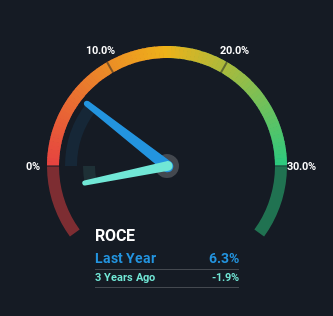- India
- /
- Hospitality
- /
- NSEI:AHLEAST
Asian Hotels (East) (NSE:AHLEAST) Is Experiencing Growth In Returns On Capital

Did you know there are some financial metrics that can provide clues of a potential multi-bagger? Firstly, we'll want to see a proven return on capital employed (ROCE) that is increasing, and secondly, an expanding base of capital employed. Put simply, these types of businesses are compounding machines, meaning they are continually reinvesting their earnings at ever-higher rates of return. With that in mind, we've noticed some promising trends at Asian Hotels (East) (NSE:AHLEAST) so let's look a bit deeper.
Return On Capital Employed (ROCE): What Is It?
For those who don't know, ROCE is a measure of a company's yearly pre-tax profit (its return), relative to the capital employed in the business. Analysts use this formula to calculate it for Asian Hotels (East):
Return on Capital Employed = Earnings Before Interest and Tax (EBIT) ÷ (Total Assets - Current Liabilities)
0.063 = ₹248m ÷ (₹6.2b - ₹2.3b) (Based on the trailing twelve months to September 2024).
Therefore, Asian Hotels (East) has an ROCE of 6.3%. Ultimately, that's a low return and it under-performs the Hospitality industry average of 9.7%.
View our latest analysis for Asian Hotels (East)

Historical performance is a great place to start when researching a stock so above you can see the gauge for Asian Hotels (East)'s ROCE against it's prior returns. If you'd like to look at how Asian Hotels (East) has performed in the past in other metrics, you can view this free graph of Asian Hotels (East)'s past earnings, revenue and cash flow.
How Are Returns Trending?
Asian Hotels (East) has not disappointed in regards to ROCE growth. The data shows that returns on capital have increased by 307% over the trailing five years. The company is now earning ₹0.06 per dollar of capital employed. Interestingly, the business may be becoming more efficient because it's applying 55% less capital than it was five years ago. A business that's shrinking its asset base like this isn't usually typical of a soon to be multi-bagger company.
For the record though, there was a noticeable increase in the company's current liabilities over the period, so we would attribute some of the ROCE growth to that. The current liabilities has increased to 37% of total assets, so the business is now more funded by the likes of its suppliers or short-term creditors. It's worth keeping an eye on this because as the percentage of current liabilities to total assets increases, some aspects of risk also increase.
The Bottom Line
In summary, it's great to see that Asian Hotels (East) has been able to turn things around and earn higher returns on lower amounts of capital. Considering the stock has delivered 33% to its stockholders over the last five years, it may be fair to think that investors aren't fully aware of the promising trends yet. Given that, we'd look further into this stock in case it has more traits that could make it multiply in the long term.
One final note, you should learn about the 4 warning signs we've spotted with Asian Hotels (East) (including 2 which are a bit concerning) .
While Asian Hotels (East) may not currently earn the highest returns, we've compiled a list of companies that currently earn more than 25% return on equity. Check out this free list here.
If you're looking to trade Asian Hotels (East), open an account with the lowest-cost platform trusted by professionals, Interactive Brokers.
With clients in over 200 countries and territories, and access to 160 markets, IBKR lets you trade stocks, options, futures, forex, bonds and funds from a single integrated account.
Enjoy no hidden fees, no account minimums, and FX conversion rates as low as 0.03%, far better than what most brokers offer.
Sponsored ContentNew: Manage All Your Stock Portfolios in One Place
We've created the ultimate portfolio companion for stock investors, and it's free.
• Connect an unlimited number of Portfolios and see your total in one currency
• Be alerted to new Warning Signs or Risks via email or mobile
• Track the Fair Value of your stocks
Have feedback on this article? Concerned about the content? Get in touch with us directly. Alternatively, email editorial-team (at) simplywallst.com.
This article by Simply Wall St is general in nature. We provide commentary based on historical data and analyst forecasts only using an unbiased methodology and our articles are not intended to be financial advice. It does not constitute a recommendation to buy or sell any stock, and does not take account of your objectives, or your financial situation. We aim to bring you long-term focused analysis driven by fundamental data. Note that our analysis may not factor in the latest price-sensitive company announcements or qualitative material. Simply Wall St has no position in any stocks mentioned.
About NSEI:AHLEAST
Proven track record average dividend payer.
Similar Companies
Market Insights
Community Narratives



